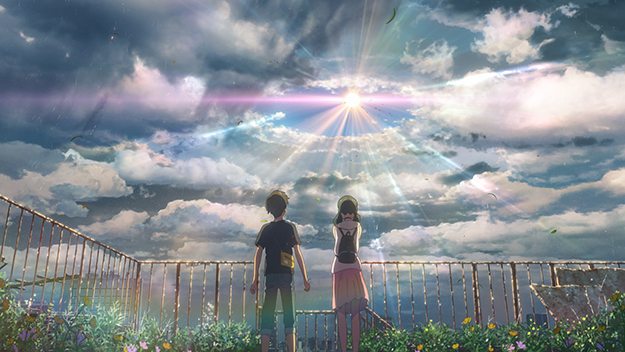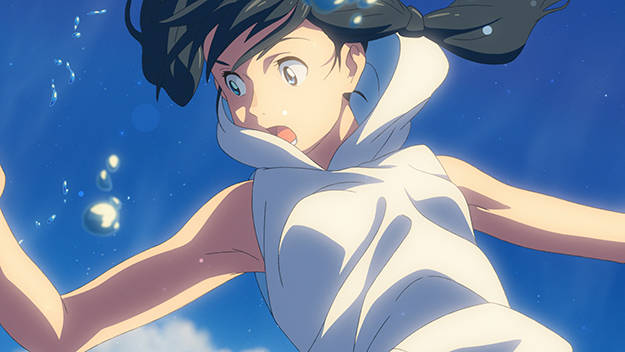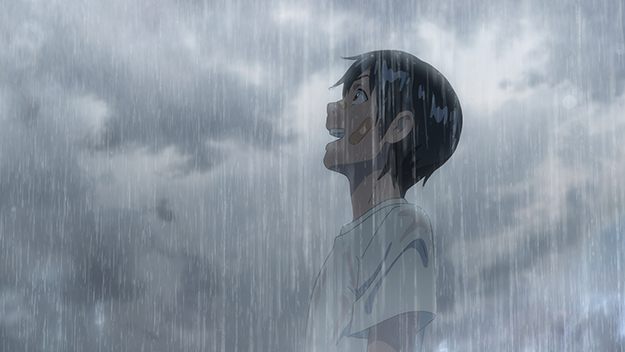Deep Focus: Weathering with You

Images from Weathering with You (Makoto Shinkai, 2020)
Makoto Shinkai’s sixth feature-length cartoon, Weathering with You, oozes visual lyricism and primal yearning. Shinkai’s characters may be “wispy” (negative spin) or “archetypal” (positive spin), his messages may be “sentimental” or (unduly) “optimistic,” but he’s a born moviemaker with an imagistic imagination. As Shinkai follows a runaway 16-year-old, Hodaka, who ships out from his island home and carves a place for himself in Tokyo during an unprecedented rain-soaked summer, the movie’s surface oscillates between harsh or seductive liquid shapes and slashes or pools of colorful, shimmering light.
Not a clichéd composition can be seen in the near-two-hour running time. Even when Hodaka pushes himself to the edge of desperation, Tokyo’s neon and LED signs register less as excess flash and filigree than as beacons for a world of dangerous beauty. When Hodaka becomes cub reporter, errand boy, and housekeeper for Mr. Suga, the editor-publisher of a struggling tabloid, the regimen of mundane chores, outrageous assignments, and gruff camaraderie fulfills his appetite for experience and serves as an ideal outlet for his bottled-up energies.
Shinkai masters the fast-changing tempi of lives built around the instant accessibility of web and digital services. It isn’t just a matter of keeping up with Hodaka’s fingers as he scrolls through the inboxes on his smartphone, but of tuning audiences to his reflexes as he takes in the hectic communications of a complex urban environment.
This film vibrates with youthful rhythms and exudes Young Adult authenticity even when Hodaka and his teenage true love, Hina, a “sunshine girl” who can halt torrents with prayers, stop making sense about climate change. Although extreme weather energizes this film’s tragicomic plot, Weathering with You eschews topical melodrama. Hina is no paranormal Greta Thunberg. She’s a virtuous teenager who simply wants to make a stable home for herself and her precocious grade-school brother Nagisa. At first we’re told that her prayers clear the sky only for limited areas and brief interludes. (Later we learn the potential epic scope of Hina’s power and the cost it exacts from her body and soul.) Hodaka convinces her that she can make enough money to pay her bills by stopping storms for a fee. The kind of business Hina attracts—breaking out the sun for public events like a flea market and a fireworks festival and private ones like a wedding and a memorial for the dead—fits her benevolent personality.

Hina cuts a poetic figure, not a political one. She gained her power when she followed a mysterious shaft of light to the top of a derelict Tokyo building and crossed through the traditional torii gate of a rooftop Shinto shrine. From that moment on, she felt “connected to the sky.” When Hodaka’s boss Mr. Suga interviews an aged Shinto priest about the phenomenon of the sunshine girl, he links her to the antique concept of a “weather maiden” in each town who would answer the citizens’ meteorological demands until she made the ultimate sacrifice. The priest laments that humans no longer realize that we’re temporary custodians of the space between the earth and the sky. All that links us to the heavens above, he says, is a slender thread; we must struggle to secure our position in the cosmos. Despite the fuzzy sermons this movie ultimately preaches about measuring personal happiness against the common good and learning to live with global warming, as a whole it instills a heightened awareness of how crucially weather affects our consciousness.
Shinkai introduces the audience and Hodaka to Hina when she’s a counter-girl at McDonald’s, sneaking a starving boy a free Big Mac. She loves doing good—that’s why she enjoys being a sunshine girl. But to survive she’s willing to break bad. When Hodaka runs into her again, she’s ready to accept a job as a B-girl in a shady saloon until Hodaka wrests her from the bar owner and brings her to her senses.
Hodaka carries a paperback of J.D. Salinger’s The Catcher in the Rye. His impulse to preserve Hina’s innocence, even before he really knows her, connects with audiences as a gallant Holden Caulfield-esque move. Shinkai’s handle on Salinger’s brand of humor and psychology keeps the film from evaporating into electric-pastel mysticism. We rarely lose sight of Hodaka’s perilous status as a runaway and Hina’s as an older sister functioning as a single mom for her kid brother Nagisa. Hodaka’s skewed, partial vision of the other people in the universe can be as poignant and hilarious in turn as Holden’s. Hodaka presumes that fun-loving, nubile Natsumi must be Mr. Suga’s mistress as well as his girl Friday after he finds her sleeping on the office couch. He idolizes Hina’s little bother Nagasi for his confidence with girls: the young boy sagely advises him that ambivalence turns females off. It’s better to be decisive at the outset of a relationship and ambiguous afterwards.

Hodaka’s emotions are so close to his skin that he tosses off sweat and tears like a dog shaking off bathwater. The effect may be uproarious when he slides into sexual panic, but it’s dead-serious when he threatens a man with a loaded gun. Shinkai comes up with visual mood swings to match: a string of bland information screens snap to fire-engine red as trains gets cancelled in a terminal; Hina free-falls out of a cumulonimbus cloud containing a leek-colored ecosystem. (Years from now, this film will make a terrific double bill with Tom Harper’s criminally underrated The Aeronauts.)
Shinkai generates considerable suspense from Hina confronting her weather maiden destiny and Japan’s flood-ravaged capital facing submersion into Tokyo Bay. Neither plot, though, comes to a satisfying close. Hodaka and Hina tamp down her self-sacrificing urges to sustain their soaring romanticism. Ultimately, they see Tokyo’s sinking soil base as an ecological phase to be endured. The title refers not to manipulating weather in order to reverse a worsening climate, but to coming through it unscathed.
Still, in the movie’s ardent mid-section, Shinkai’s portrait of a boy who must stay true to his deepest feelings gives Weathering with You haunting glimmers of depth. What Anthony Burgess writes about Holden Caulfield in the novelist-critic’s 99 Novels applies spot-on to Hodaka. He’s “more a gentle voice of protest, unprevailing in the noise, than a militant world-changer.” To paraphrase Burgess, at a time of “ghastly pseudo-peace,” when youth rises up to condemn “the failures of the adult world,” the cry for help of a “decent perplexed adolescent” may prove to be “the most telling.”
Michael Sragow is a contributing editor to Film Comment and writes its Deep Focus column. He is a member of the National Society of Film Critics and the Los Angeles Film Critics Association.







